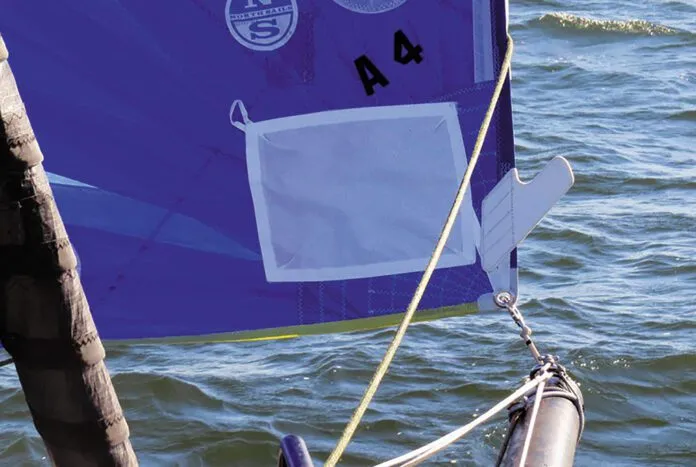Last month’s report on preventing jib sheets for snagging while tacking (see “In Search of the Snag-free Clew,” PS February 2024) brought up a reader question about avoiding snags when changing tacks with an asymmetrical spinnaker (also called a gennaker).
Boats that are faster than the wind on a broad reach—performance multihulls and planing skiffs—tack downwind, with the apparent wind rotating across the bow, not around the stern. On these faster boats, the apparent wind blows the sail aft, so it is natural to pass the sheets between the luff and the forestay and perform what is called an inside jibe.
In light winds, an inside jibe can also be a faster method for slower boats to tack an asymmetrical sail, but this generally requires a crew member on the foredeck to pull the tack around the forestay. If the asymmetrical spinnaker is set from a bow sprit, creating a sufficient gap between the spinnaker and the forestay, an inside tack is easier.
If you can’t pull the tack around quickly during an inside jibe, the rest of the sail will wrap around the forestay. If this happens, immediately jibe back to the original tack, sheet in, and the wrap should come free. If a sail wrap worries you, there’s no shame in lowering the gennaker and resetting it. Many experienced solo sailors find this the smart choice in a breeze. If you have a spinnaker sock (snuffer, squeezer, etc.), or top-down furling, you can douse sail, jibe, and redeploy.
In theory, the rest of us should do an outside jibe. The sheets pass forward of the tack while the clew (and the rest of the sail) blows ahead of the tack as the apparent wind rotates aft. You can still wrap the sail if you turn too slowly or don’t bring the sheets around at a rate matching the sail.
The downside of an outside jibe is that the sheets like to fall in the water in front of the boat and get run over. If the sheets also hang up on the furler drum or wrap around the anchor, things can get ugly. This isn’t an issue on cruising catamarans because the sheets stay inside the bows, where they can’t get run over, and there is little to snag on. With wide foredecks, cats are generally immune to these dangers, but on monohulls, you need to be watchful.
There are several preventive measures. Lightweight, floating sheets a less likely to get run over. A batten along the foot of the sail, protruding about 12 inches forward of the tack can provide a shelf for the sheets to rest on (see photo), keeping them out of the water and away from the anchor. A batten taped to the top pulpit railing can do the same job. Keeping some back tension on the lazy sheet helps. In any case, you’ll also want to apply the other remedy for sail wraps and snags—practice.






































